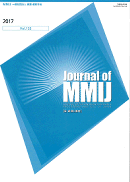
- |<
- <
- 1
- >
- >|
-
Dagvadorj OTGONJARGAL, Dai NAKAMURA, Takayuki KAWAGUCHI, Tatsuya WATA ...Article type: Original paper
2021 Volume 137 Issue 7 Pages 69-78
Published: July 31, 2021
Released on J-STAGE: July 31, 2021
JOURNAL OPEN ACCESSIn this study,field surveys were carried out at the damaged area of slope stabilization works,where the main cause was presumed to be the frost heaving of the rock mass.Field measurements of the freezing depth and the amount of frost heave were also conducted.In addition, the effectiveness of the slope stabilization work with the frost heave measures was verified based on the investigation results.The findings are summarized as follows. (1) From the results of the field survey and the field measurements,it was found that even if frost heaving occurred in the extreme surface layer, the rock mass would be degraded and the slope stabilization work would be affected.(2)From the results of the frost heaving tests, it is clear that the frost susceptibility of the damaged rock slope is extremely high, and there was wide agreement between the results of the frost heaving tests and the results of determining the frost susceptibility of the damaged rock slope using a simple strength test method. Therefore, the validity of the simple method proposed by Nakamura et al. for determining the frost susceptibility of rocks by using the strength test was also verified. (3)It was confirmed that both the gabion and the continuous fiber reinforced soil work were effective in preventing the freezing front from advancing into the rock mass.The method of covering the rock slope with non-frost susceptible material to prevent the penetration of the freezing front was found to be effective as a countermeasure against frost heaving.
View full abstractDownload PDF (7594K)
- |<
- <
- 1
- >
- >|